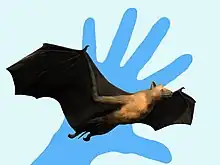Icaronycteris
Icaronycteris is an extinct genus of microchiropteran (echolocating) bat that lived in the early Eocene, approximately 52.2 million years ago, making it the earliest known definitive bat.[1] Four exceptionally preserved specimens, among the best preserved bat fossils, are known from the Green River Formation of North America.[1] The best known species is I. index.[2] Fragmentary material from France has also been tentatively placed within Icaronycteris as the second species I. menui.[3] I. sigei is based on well-preserved fragments of dentaries and lower teeth found in Western India.[4] In 2023, the species I. gunnelli also from the Green River Formation was distinguished from I. index, and I. menui and I. sigei were proposed to be removed from the genus due to them not being closely related.[5]
| Icaronycteris Temporal range: | |
|---|---|
 | |
| Fossil specimen of I. index in the ROM | |
_dorsal_view.jpg.webp) | |
| Fossil specimen of I. gunnelli | |
| Scientific classification | |
| Domain: | Eukaryota |
| Kingdom: | Animalia |
| Phylum: | Chordata |
| Class: | Mammalia |
| Order: | Chiroptera |
| Family: | †Icaronycteridae |
| Genus: | †Icaronycteris Jepsen 1966 |
| Species | |
| |
Description

Icaronycteris[6] measured about 14 centimetres (5.5 in) long and had a wingspan of 37 centimetres (15 in). It closely resembled modern bats, but had some primitive traits. The tail was much longer and not connected to the hind legs with a skin membrane, the first wing finger bore a claw and the body was more flexible. Similarly, it had a full set of relatively unspecialised teeth, similar to those of a modern shrew. Its anatomy suggests that, like modern bats, Icaronycteris slept while hanging upside down, holding onto a tree branch or stone ridge with its hind legs.[7]
Phylogeny
According to Simmons & Geisler 1998,[8] Icaronycteris is the first genus, followed by Archaeonycteris, Hassianycetris, and Palaeochiropteryx, in a series leading to extant microchiropteran bats.[9]
Rietbergen et al. 2023 found Onychonycteris to be sister to the North American species of Icaronycteris.
| ← |
| |||||||||||||||||||||||||||
See also
References
Notes
- Gunnell & Simmons 2005, Fossil Bats, p. 214
- Jepsen 1966
- Simmons & Geisler 1998, p. 40
- Smith et al. 2007, Abstract
- Rietbergen et al. 2023
- The name relates the mythic flight of Icarus to Nycteris, the genus of "hollow-faced bats".
- Palmer 1999, p. 211
- Simmons & Geisler 1998, Abstract
- Simmons & Conway 1998, Discussion of Phylogenetic Relationships
- Simmons & Conway 1998
Sources
- Gunnell, G. F.; Simmons, N. B. (2005). "Fossil evidence and the origin of bats" (PDF). Journal of Mammalian Evolution. 12 (1–2): 209–246. doi:10.1007/s10914-005-6945-2. hdl:2027.42/44972.
- Jepsen, G. L. (1966). "Early Eocene bat from Wyoming". Science. 154 (3754): 1333–9. Bibcode:1966Sci...154.1333J. doi:10.1126/science.154.3754.1333. PMID 17770307.
- Palmer, D., ed. (1999). The Marshall Illustrated Encyclopedia of Dinosaurs and Prehistoric Animals. London: Marshall Editions. ISBN 978-1-84028-152-1.
- Rietbergen, Tim B.; Ostende, Lars W. van den Hoek; Aase, Arvid; Jones, Matthew F.; Medeiros, Edward D.; Simmons, Nancy B. (12 April 2023). "The oldest known bat skeletons and their implications for Eocene chiropteran diversification". PLOS ONE. 18 (4): e0283505. doi:10.1371/journal.pone.0283505. ISSN 1932-6203. PMC 10096270.
- Russell, D. E.; Louis, P.; Savage, D. E. (1973). "Chiroptera and Dermoptera of the French early Eocene". University of California Publications in Geological Sciences. 95: 1–57. OCLC 691130847.
- Smith, T.; Rana, R. S.; Missiaen, P.; Rose, K. D.; Sahni, A.; Singh, H.; Singh, L. (2007). "High bat (Chiroptera) diversity in the Early Eocene of India". Naturwissenschaften. 94 (12): 1003–1009. Bibcode:2007NW.....94.1003S. doi:10.1007/s00114-007-0280-9. hdl:1854/LU-385394. PMID 17671774.
- Simmons, N. B.; Conway, T. (1998). "Chiroptera". Tree of Life. Retrieved 1 September 2014.
- Simmons, N. B.; Geisler, J. H. (1998). "Phylogenetic relationships of Icaronycteris, Archaeonycteris, Hassianycteris, and Palaeochiropteryx to extant bat lineages, with comments on the evolution of echolocation and foraging strategies in Microchiroptera" (PDF). Bulletin of the AMNH (235).
Further reading
- Cox, Barry; Harrison, Colin; Savage, R. J. G.; Gardiner, Brian (1999). The Simon & Schuster Encyclopedia of Dinosaurs and Prehistoric Creatures: A Visual Who's Who of Prehistoric Life. Simon & Schuster. ISBN 978-0-684-86411-2. OCLC 40943525.
- Naish, Darren; Wyse, Liz (2001). Parsons, Jayne (ed.). Dinosaur Encyclopedia. Dorling Kindersley. ISBN 9780789479358.
- Richardson, Hazel (2003). Dinosaurs and Other Prehistoric Animals. Smithsonian Handbooks. Dorling Kindersley. p. 170. ISBN 978-0789493613. OCLC 52532157. OL 8156728M.
- Norman, David (2001). The Big Book Of Dinosaurs. Welcome Books. p. 119. ISBN 978-0941807487. OCLC 47522057.